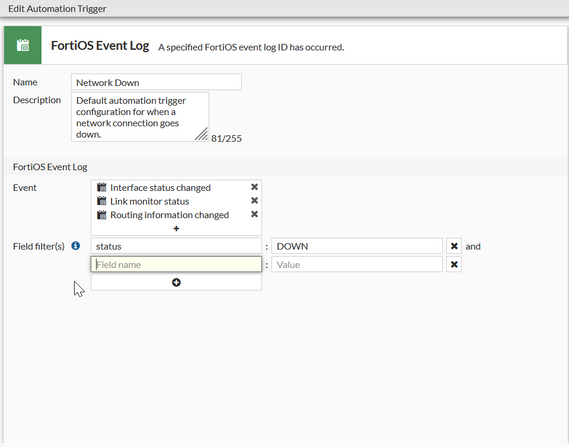- Support Forum
- Knowledge Base
- Customer Service
- Internal Article Nominations
- FortiGate
- FortiClient
- FortiADC
- FortiAIOps
- FortiAnalyzer
- FortiAP
- FortiAuthenticator
- FortiBridge
- FortiCache
- FortiCare Services
- FortiCarrier
- FortiCASB
- FortiConverter
- FortiCNP
- FortiDAST
- FortiData
- FortiDDoS
- FortiDB
- FortiDNS
- FortiDLP
- FortiDeceptor
- FortiDevice
- FortiDevSec
- FortiDirector
- FortiEdgeCloud
- FortiEDR
- FortiEndpoint
- FortiExtender
- FortiGate Cloud
- FortiGuard
- FortiGuest
- FortiHypervisor
- FortiInsight
- FortiIsolator
- FortiMail
- FortiManager
- FortiMonitor
- FortiNAC
- FortiNAC-F
- FortiNDR (on-premise)
- FortiNDRCloud
- FortiPAM
- FortiPhish
- FortiPortal
- FortiPresence
- FortiProxy
- FortiRecon
- FortiRecorder
- FortiSRA
- FortiSandbox
- FortiSASE
- FortiSASE Sovereign
- FortiScan
- FortiSIEM
- FortiSOAR
- FortiSwitch
- FortiTester
- FortiToken
- FortiVoice
- FortiWAN
- FortiWeb
- FortiAppSec Cloud
- Lacework
- Wireless Controller
- RMA Information and Announcements
- FortiCloud Products
- ZTNA
- 4D Documents
- Customer Service
- Community Groups
- Blogs
- Fortinet Community
- Knowledge Base
- FortiGate
- Technical Tip: Creating automation stitches in For...
- Subscribe to RSS Feed
- Mark as New
- Mark as Read
- Bookmark
- Subscribe
- Printer Friendly Page
- Report Inappropriate Content
Created on
08-01-2021
10:45 AM
Edited on
03-30-2023
01:31 AM
By
![]() Jean-Philippe_P
Jean-Philippe_P
Description
This article describes how to configure FortiGate to automatically respond to various trigger events. This article is for FortiOS 7.0 and 7.2 - the automation workflow was redesigned to be more efficient and clearer for the user.
Solution
Automation stitches, actions, and triggers have separate dialogs and are no longer part of the main automation stitch dialog like in previous FortiOS versions (6.2, 6.4).
1) When creating a stitch, selecting 'Add Trigger' or 'Add Action' displays a list of available triggers and actions, and also the option to create new ones.
2) Once the stitch is configured, a process diagram of the trigger, actions, and delays is displayed.
Notice the 'Action execution' options - it allows to choose if additional actions are executed in a specific order ('Sequential') or simultaneously ('Parallel'). If you choose 'Sequential', it is possible to configure a delay between actions in seconds ('Add delay' button). However, if one of the actions fails, then the next actions will not be executed and the automation stitch will stop.
Select a trigger from the list, e.g. 'Network Down' and add events to which automation will react when executing the stitch:
- Select 'Link monitor status' if the link monitor is configured;
- Select 'Routing information changed' if SD WAN is configured with performance SLA;

Not all the triggers can be edited if based on some singular FortiOS event, e.g. reboot or failover.
The trigger can be also configured as a recurring schedule (hourly, daily, etc) for a specific action:
Other possible triggers:
To configure an action or update an existing one:
One of the most widespread actions is sending an email to the administrator after a specific event has happened. To configure it, select 'Default Email' on the Action page and specify the recipient(s) and subject:

Another popular activity is running a CLI script - for example, it can be used to restart a process if automation gets triggered by 'High CPU' or 'Conserve Mode' triggers. To configure it, chose 'Create New' on the Action page and find 'CLI Script':

The commands can be either specified manually or recorded in the console widget.

edit "Network Down"
set status enable
set trigger "Network Down"
# config actions
edit 1
set action "Default Email"
edit "Network Down"
set event-type event-log
set logid 22922 22921 -> ID of the Event logs chosen for this trigger.
end
edit "Default Email"
set action-type email
set email-from <Email sender name>
set email-to <email-address>
set email-subject <subject-name>
set minimum-interval <seconds> -> default value is 0.
end
The Fortinet Security Fabric brings together the concepts of convergence and consolidation to provide comprehensive cybersecurity protection for all users, devices, and applications and across all network edges.
Copyright 2026 Fortinet, Inc. All Rights Reserved.



